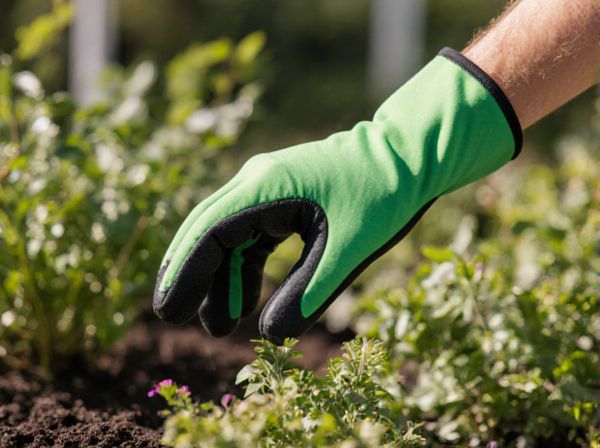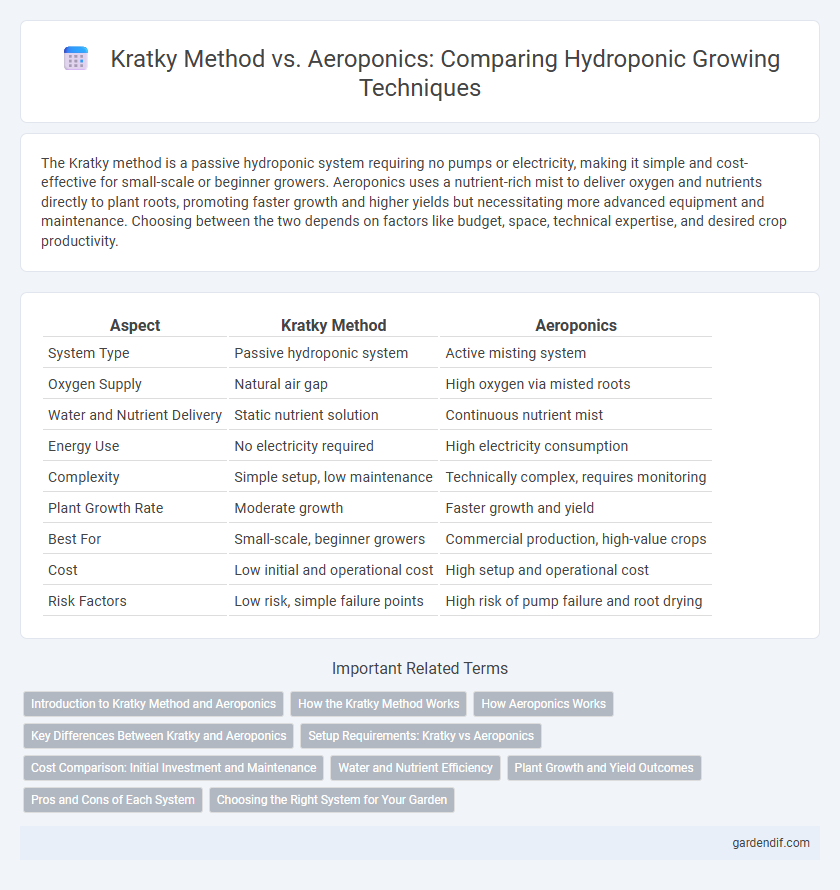
Kratky Method vs Aeroponics Illustration
The Kratky method is a passive hydroponic system requiring no pumps or electricity, making it simple and cost-effective for small-scale or beginner growers. Aeroponics uses a nutrient-rich mist to deliver oxygen and nutrients directly to plant roots, promoting faster growth and higher yields but necessitating more advanced equipment and maintenance. Choosing between the two depends on factors like budget, space, technical expertise, and desired crop productivity.
Table of Comparison
| Aspect | Kratky Method | Aeroponics |
|---|---|---|
| System Type | Passive hydroponic system | Active misting system |
| Oxygen Supply | Natural air gap | High oxygen via misted roots |
| Water and Nutrient Delivery | Static nutrient solution | Continuous nutrient mist |
| Energy Use | No electricity required | High electricity consumption |
| Complexity | Simple setup, low maintenance | Technically complex, requires monitoring |
| Plant Growth Rate | Moderate growth | Faster growth and yield |
| Best For | Small-scale, beginner growers | Commercial production, high-value crops |
| Cost | Low initial and operational cost | High setup and operational cost |
| Risk Factors | Low risk, simple failure points | High risk of pump failure and root drying |
Introduction to Kratky Method and Aeroponics
The Kratky Method is a passive hydroponic technique that requires no pumps or electricity, making it highly energy-efficient and ideal for small-scale or beginner growers. Aeroponics, by contrast, involves suspending plant roots in air and misting them with nutrient solution, promoting faster growth through enhanced oxygen exposure and nutrient absorption. Both systems optimize water and nutrient delivery but differ significantly in complexity, operational costs, and scalability.
How the Kratky Method Works
The Kratky Method operates as a passive hydroponic technique where plants are suspended above a nutrient solution with roots submerged, relying on oxygen from the air gap rather than continuous aeration. This method enables oxygen absorption through the exposed root zone while nutrients are absorbed directly from the water reservoir without pumps or electricity. Compared to aeroponics, which mists roots in a nutrient-rich air environment, the Kratky Method is simpler, low-maintenance, and ideal for small-scale or hobby hydroponic systems.
How Aeroponics Works
Aeroponics operates by suspending plant roots in a nutrient-rich mist, allowing maximum oxygen exposure and nutrient absorption without the use of soil or growing media. This method enhances plant growth rates and water efficiency compared to traditional hydroponic systems like the Kratky Method, which relies on stagnant nutrient solutions. Aeroponics systems utilize high-pressure nozzles to deliver fine mist droplets directly to roots, optimizing nutrient uptake and reducing disease risk through improved aeration.
Key Differences Between Kratky and Aeroponics
The Kratky method is a passive hydroponic technique relying on a static nutrient solution without aeration, while aeroponics actively sprays nutrient-rich mist onto plant roots suspended in air, enhancing oxygen availability. Kratky systems are simpler, low-maintenance, and ideal for small-scale or beginner growers, whereas aeroponics offers faster growth rates and higher yields due to improved root oxygenation and nutrient uptake. The main difference lies in the oxygen delivery mechanism: Kratky depends on air exposure at the nutrient surface, and aeroponics uses advanced misting to optimize root respiration.
Setup Requirements: Kratky vs Aeroponics
The Kratky method requires minimal setup, utilizing a simple container with a nutrient solution and net pots, making it highly accessible for beginners and low-budget growers. In contrast, aeroponics demands a more complex system including misting devices, pumps, and timers to deliver nutrient-rich water as a fine mist, resulting in higher initial costs and maintenance. While Kratky offers a passive, soil-less technique with no electricity needed, aeroponics provides superior oxygenation and faster plant growth but requires precise control and technical expertise.
Cost Comparison: Initial Investment and Maintenance
The Kratky method requires minimal initial investment, relying on simple containers and nutrient solutions without pumps or electrical components, making it highly cost-effective for beginners and small-scale growers. Aeroponics systems demand a higher upfront cost due to the need for misting nozzles, pumps, and advanced control units, increasing equipment expenses and energy consumption. Maintenance costs for Kratky remain low with minimal monitoring, while aeroponics involves regular system checks and replacement of mechanical parts, elevating ongoing expenses.
Water and Nutrient Efficiency
The Kratky method uses a static water and nutrient solution, minimizing water usage by eliminating the need for pumps or aeration, making it highly efficient for small-scale hydroponics. Aeroponics delivers nutrients via a mist, enhancing oxygen availability to roots but consuming more water due to continuous spraying and evaporation. Comparing both, the Kratky method achieves superior water and nutrient conservation, while aeroponics offers faster growth rates at the cost of higher resource input.
Plant Growth and Yield Outcomes
The Kratky method supports steady plant growth by providing a static nutrient solution that ensures roots absorb ample oxygen and nutrients without the need for pumps, making it ideal for leafy greens and herbs with moderate yield expectations. In contrast, aeroponics delivers nutrient-rich mist directly to exposed roots, significantly enhancing oxygen availability and accelerating growth rates, resulting in higher yields and faster crop cycles, especially for fruiting plants. While Kratky offers simplicity and low cost, aeroponics demands more technical investment but maximizes plant productivity and efficiency in controlled environments.
Pros and Cons of Each System
The Kratky method requires no electricity or pumps, making it cost-effective and easy to set up for passive hydroponic growing, but it limits oxygen supply to roots and is less suited for larger or long-term crops. Aeroponics delivers nutrient-rich mist directly to plant roots, maximizing oxygen exposure and promoting rapid growth, yet it demands consistent power and maintenance, increasing operational complexity and risk of system failure. While Kratky excels in simplicity and affordability, aeroponics offers superior growth efficiency and scalability for commercial applications.
Choosing the Right System for Your Garden
The Kratky Method offers a low-maintenance, soil-free hydroponic system ideal for beginners and small-scale gardens by using a passive nutrient solution technique without pumps or electricity. Aeroponics provides faster plant growth and higher oxygen availability to roots through misting nutrient solutions, making it suitable for commercial growers seeking rapid crop cycles and maximizing yields. Choosing the right system depends on factors like available space, budget, technical skill, and desired crop productivity to optimize garden performance effectively.
Kratky Method vs Aeroponics Infographic

 gardendif.com
gardendif.com